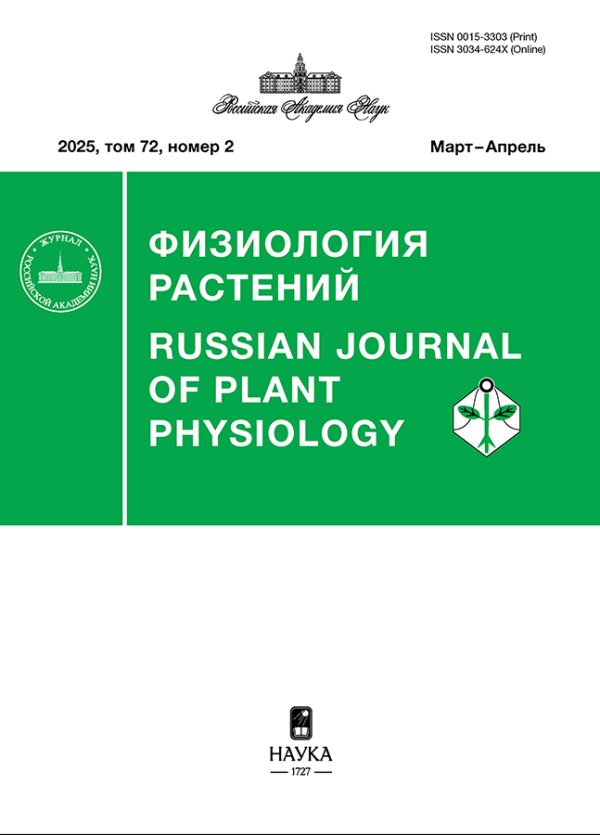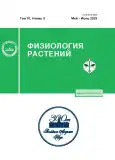Effect of Photoperiod Duration on Efficiency of Low-Temperature Hardening of Arabidopsis thaliana Heynh. (L.)
- Authors: Popov V.N.1, Deryabin A.N.1
-
Affiliations:
- Timiryazev Institute of Plant Physiology, Russian Academy of Sciences
- Issue: Vol 70, No 3 (2023)
- Pages: 311-318
- Section: ЭКСПЕРИМЕНТАЛЬНЫЕ СТАТЬИ
- URL: https://journals.rcsi.science/0015-3303/article/view/130218
- DOI: https://doi.org/10.31857/S0015330322600619
- EDN: https://elibrary.ru/IASUAI
- ID: 130218
Cite item
Full Text
Abstract
The effect of photoperiod duration on efficiency of low-temperature hardening was investigated in Arabidopsis thaliana (L.) Heynh. plants, ecotype Col-0. Six-week-old plants were exposed to cold acclimation at a temperature of 2°С during 1‒5 days at photoperiods of 0, 8, and 16 h (illuminance of 200 µmol/(m2 s)). According to survival data and leakage of electrolytes after test freezing (–6°C, 24 h), the plants exposed to cold acclimation in the dark did not show frost resistance. The plants hardened in the light (irrespective of the length of photoperiod) considerably improved their frost resistance by the end of the cold-acclimation period. Net photosynthesis/dark respiration ratio in these plants was almost two times greater than in control material (without hardening). The plants exposed to a 16-h-long photoperiod surpassed the type of treatment with 8-h-long illumination both in the highest levels of accumulation of sugars (by almost 40%) and in the rate of reaching these levels in daily dynamics of hardening. It was shown that MDA content transiently rose during the first 24 h of hardening in the light and did not change in the dark, which may point to a signal role of lipid peroxidation products upon cold acclimation. It was discovered that the photoperiod duration affected the formation rate of frost resistance in A. thaliana plants. A more prolonged operation of A. thaliana’s photosynthetic apparatus at 16-h-long photoperiod considerably accelerated the accumulation of sugars upon cold acclimation and, therefore, hastened development of frost resistance as compared with an 8-h-long photoperiod. It was concluded that rapid formation of frost resistance in A. thaliana requires a combination of low above-zero temperature and 16-h-long photoperiod.
About the authors
Valery N. Popov
Timiryazev Institute of Plant Physiology, Russian Academy of Sciences
Author for correspondence.
Email: vnpopov@mail.ru
Russian Federation, Moscow
Alexander N. Deryabin
Timiryazev Institute of Plant Physiology, Russian Academy of Sciences
Email: vnpopov@mail.ru
Russian Federation, Moscow
References
- Nievola C.C., Carvalho C.P., Carvalho V., Rodrigues E. Rapid responses of plants to temperature changes // Temperature. 2017. V. 4. P. 371. https://doi.org/10.1080/23328940.2017.1377812
- Larcher W. Physiological Plant Ecology. Ecophysiology and stress physiology of functional groups. Springer: Berlin, Heidelberg, New York, 2003. P. 513.
- Трунова Т.И. Растение и низкотемпературный стресс. 64-е Тимирязевские чтения. М.: Наука, 2007. 54 с.
- Theocharis A., Clement C., Barka E.A. Physiological and molecular changes in plants grown at low temperatures // Planta. 2012. V. 235. P. 1091. https://doi.org/10.1007/s00425-012-1641-y
- Rihan H.Z., Al-Issawi M., Fuller M.P. Advances in physiological and molecular aspects of plant cold tolerance // J. Plant Interact. 2017. V. 12. P. 143. https://doi.org/10.1080/17429145.2017.1308568
- Weiser C.J. Cold resistance and injury in woody plants: Knowledge of hardy plant adaptations to freezing stress may help us to reduce winter damage // Science. 1970. V. 169. P. 1269. https://doi.org/10.1126/science.169.3952.1269
- Maurya J.P., Bhalerao R.P. Photoperiod and temperature mediated control of growth cessation and dormancy in trees: a molecular perspective // Ann. Bot. 2017. V. 120. P. 351. https://doi.org/10.1093/aob/mcx061
- Wanner L.A., Junttila O. Cold-Induced Freezing Tolerance in Arabidopsis // Plant Physiology. 1999. V. 120. P. 391. https://doi.org/10.1104/pp.120.2.391
- Lee C.M., Thomashow M.F. Photoperiodic regulation of the C-repeat binding factor (CBF) cold acclimation pathway and freezing tolerance in Arabidopsis thaliana // PNAS. 2012. V. 109. P. 15054. https://doi.org/10.1073/pnas.1211295109
- Трунова Т.И. Световой и температурный режимы при закаливании озимой пшеницы и значение олигосахаридов для морозостойкости // Физиология растений. 1965. Т. 12. С. 85.
- Xin Z., Browse J. Cold comfort farm: the acclimation of plants to freezing temperatures // Plant Cell Environ. 2000. V. 23. P. 893. https://doi.org/10.1046/j.1365-3040.2000.00611.x
- Campos P.S., Quartin V., Ramalho J.C., Nunes M.A. Electrolyte leakage and lipid degradation account for cold sensitivity in leaves of Coffea sp. plants // J. Plant Physiol. 2003. V. 160. P. 283. https://doi.org/10.1078/0176-1617-00833
- Klimov S.V., Astakhova N.V., Trunova T.I. Changes in Photosynthesis, Dark Respiration Rates and Photosynthetic Carbon Partitioning in Winter Rye and Wheat Seedlings during Cold Hardening // J. Plant Physiol. 1999. V. 155. P. 734.
- Туркина М.В., Соколова С.В. Методы определения моносахаридов и олигосахаридов // Биохимические методы в физиологии растений / Под ред. Павлиновой О.А. М.: Наука, 1971. 7 с.
- Heath R.L., Packer L. Photoperoxidation in isolated chloroplasts. I. Kinetics and stoichiometry of fatty acid peroxidation // Arch Biochem. Biophys. 1968. V. 125. P. 189. https://doi.org/10.1016/0003- 9861(68)90654-1
- Zuther E., Schulz E., Childs L.H., Hincha D.K. Clinal variation in the non-acclimated and cold–acclimated freezing tolerance of Arabidopsis thaliana accessions // Plant Cell Environ. 2012. V. 35. P. 1860. https://doi.org/10.1111/j.1365-3040.2012.02522.x
- Catala R., Medina J., Salinas J. Integration of low temperature and light signaling during cold acclimation response in Arabidopsis // PNAS. 2011. V. 108 P. 16475. https://doi.org/10.1073/pnas.1107161108
- Ashworth E.N., Pearce R.S. Extracellular freezing in leaves of freezing-sensitive species // Planta. 2002. V. 214. P. 798. https://doi.org/10.1007/s00425-001-0683-3
- Reyes-Diaz M., Ulloa N., Zuniga-Feest A., Gutierrez A., Gidekel M., Alberdi M., Corcuera L.J., Bravo L.A. Arabidopsis thaliana avoids freezing by supercooling // J. Exp. Bot. 2006. V. 57. P. 3687. https://doi.org/10.1093/jxb/erl125
- Deryabin A.N., Trunova T.I. Colligative effects of solutions of low-molecular sugars and their role in plants under hypothermia // Biol Bull Russ Acad Sci. 2021. V. 48. P. 29. https://doi.org/10.1134/S1062359021060042
- Kreslavski V.D., Los D.A., Allakhverdiev S.I., Kuznetsov V.V. Signaling role of reactive oxygen species in plants under stress // Russ. J. Plant Physiol. 2012. V. 59. P. 141. https://doi.org/10.1134/S1021443712020057
- Foyer C.H., Noctor G. Redox regulation in photosynthetic organisms: signaling, acclimation and practical implications // Antioxid. Redox Signal. 2009. V. 11. P. 861. https://doi.org/10.1089/ars.2008.2177
- Shulaev V., Oliver D.J. Metabolic and proteomic markers for oxidative stress. New tools for reactive oxygen species research // Plant Physiol. 2006. V. 141. P. 367. https://doi.org/10.1104/pp.106.077925
- Mori I.C., Schroeder J.I. Reactive Oxygen Species Activation of Plant Ca2+ Channels: A Signaling Mechanism in Polar Growth, Hormone Transduction, Stress Signaling, and Hypothetically Mechanotransduction // Plant Physiol. 2004. V. 135. P. 702. https://doi.org/10.1104/pp.104.042069
- Pitzschke P., Hirt H. Mitogen Activated Protein Kinases and Reactive Oxygen Species Signaling in Plants // Plant Physiol. 2006. V. 141. P. 351. https://doi.org/10.1104/pp.106.079160
- Foyer C.H., Noctor G. Redox Homeostis and Antioxidant Signaling: A Metabolic Interface between Stress Perception and Physiological Responses // Plant Cell. 2005. V. 17. P. 1866. https://doi.org/10.1105/tpc.105.033589
- Soitamo A.J., Piippo M., Allahverdiyeva Y., Battchikova N., Aro E.M. Light has a specific role in modulating Arabidopsis gene expression at low temperature // BMC Plant Biology. 2008. V. 8. P. 13. https://doi.org/10.1186/1471-2229-8-13
- Kim H.J., Kim Y.K., Park J.Y., Kim J. Light signalling mediated by phytochrome plays an important role in cold-induced gene expression through the C-repeat/dehydration responsive element (C/DRE) in Arabidopsis thaliana // Plant J. 2002. V. 29. P. 693. https://doi.org/10.1046/j.1365-313x.2002.01249.x
- Crosatti C., Polverino de Laureto P., Bassi R., Cattivelli L. The interaction between cold and light controls the expression of the cold-regulated barley gene cor14b and the accumulation of the corresponding protein // Plant Physiol. 1999. V. 119. P. 671. https://doi.org/10.1104/pp.119.2.671
- Zhang R., Gonze D., Hou X., You X., Goldbeter A. A computational model for the cold response pathway in plants // Frontiers in physiology. 2020. V. 11. e591073. https://doi.org/10.3389/fphys.2020.591073
- Zhao C., Zhang Z., Xie S., Si T., Li Y., Zhu J.K. Mutational evidence for the critical role of CBF transcription factors in cold acclimation in Arabidopsis // Plant Physiol. 2016. V. 171. P. 2744. https://doi.org/10.1104/pp.16.00533
Supplementary files













